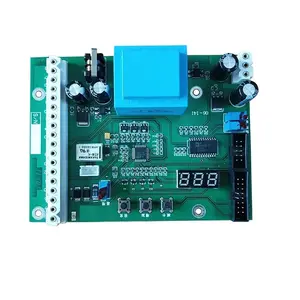Hard Drives Double-sided PCB Assembly – PCBA Manufacturer
Name: Hard Drives Double-sided PCB Assembly – PCBA Manufacturer
Origin: China
Certified: UL, CE, RoHS
Copper Thickness: 0.5-50OZ
Base Material: FR4, High TG FR4, CEM-3, etc.
Layer: 2-50layers&above
Application: communication, automobile, industrial control, etc.
Are you interested to know about Hard Drives Double-sided PCB Assembly?
It is a technique connecting two printed circuit boards (PCBs) to increase the available storage space. This assembly procedure may significantly increase the number of components that can be placed on a single board, which involves inserting components on both sides of the PCBs. Hard Drives Double-sided PCB Assembly provides several benefits over conventional single-sided assembly. This assembly can save manufacturing costs, enhance signal integrity, and minimize component housing area requirements.
Distribution of power and greater signal integrity is made possible by double-sided PCBs. The extra routing layer allows for better control of the ground and power planes, lowering noise and improving data transmission quality. As a result, data is stored and retrieved more reliably, increasing the hard drive’s storage capacity.
How Does Hard Drive Double-Sided PCB Assembly Maximize Data Storage Capacity?
Hard drives are necessary parts of modern equipment like computers. They must be dependable and effective since they are used to store and access data. Due to its affordability and durability, double-sided printed circuit board (PCB) assembly is becoming increasingly common in the construction of hard drives, which calls for a high degree of precision. The Hard Drives Double-sided PCB Assembly is essential for maximizing its capacity for data storage. Manufacturers may easily enhance storage density and fit more data into the same physical area using both sides of the printed circuit board. The following are some ways that the double-sided PCB construction helps to maximize data storage capacity:
-
Component Mounting on Both Sides of the Board:
Double-sided PCBs enable the mounting of components on both the top and bottom of the board. As a result, the number of components that manufacturers may mount—including integrated circuits, resistors, capacitors, and other electronic components—increases, and the PCB’s functioning is improved.
The double-sided PCB design offers more room for routing traces and connecting the components. This enables interconnection patterns that are more intricate and condensed, which increases the density of data paths within the hard disc. The enhanced interconnectivity improves the drive’s overall performance and capacity for data transfer.
-
Smaller Form Factor:
The hard drive’s total footprint is smaller because of the ability to use both sides of the PCB. Manufacturers can fit more hard drives into physical areas, such as server racks or data centers, using a smaller form factor. Thanks to the rise in density, higher storage capacity is possible in the same physical footprint.
- Advanced Manufacturing Techniques:
Surface mount technology (SMT) and through-hole plating are two examples of sophisticated manufacturing processes frequently used in double-sided PCB assembly. These strategies guarantee effective space utilization and maximum data storage capacity by allowing components and interconnect to be placed on both sides of the board.






